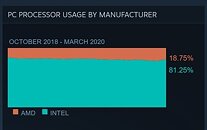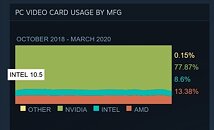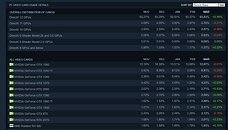Raevenlord
News Editor
- Joined
- Aug 12, 2016
- Messages
- 3,755 (1.24/day)
- Location
- Portugal
| System Name | The Ryzening |
|---|---|
| Processor | AMD Ryzen 9 5900X |
| Motherboard | MSI X570 MAG TOMAHAWK |
| Cooling | Lian Li Galahad 360mm AIO |
| Memory | 32 GB G.Skill Trident Z F4-3733 (4x 8 GB) |
| Video Card(s) | Gigabyte RTX 3070 Ti |
| Storage | Boot: Transcend MTE220S 2TB, Kintson A2000 1TB, Seagate Firewolf Pro 14 TB |
| Display(s) | Acer Nitro VG270UP (1440p 144 Hz IPS) |
| Case | Lian Li O11DX Dynamic White |
| Audio Device(s) | iFi Audio Zen DAC |
| Power Supply | Seasonic Focus+ 750 W |
| Mouse | Cooler Master Masterkeys Lite L |
| Keyboard | Cooler Master Masterkeys Lite L |
| Software | Windows 10 x64 |
Steam has just released its hardware survey for March 2020, and it paints an interesting picture on the overall Steam user market. First of all, a disclaimer: Steam's survey's don't refer to the entirety of the systems that are running its digital distribution platform; it hails from only a part of the connected machines which are randomly selected - ideally, in such as way so as for its hardware data to be representative of the overall Steam ecosystem.
The March 2020 hardware survey shows Intel CPUs gaining traction over AMD's, albeit in a very limited fashion (a 0.24% increase in total number of machines running with GenuineIntel CPUs). Cross referencing this increase with the average clockspeeds of Intel CPUs, though, paints an interesting picture: the higher clockspeeds in the 3.3 to 3.8 GHz range (which can relatively cleanly be associated with the company's higher-performance products), saw a decline in usage (contrary to AMD, which saw the reverse happening).



The increase in Intel's numbers comes, instead, from lower-clocked parts, with the most significant increase being in the 2.7 GHz to 2.99 GHz range. Add to this the fact that Intel's increase in the Steam survey occurs in the month of March, when teleworking and the "bubble quarantine" began, and this actually seems like it's mostly motivated by users either turning on their older laptops, or as a result of increased sale of said laptops (where Intel still has a dominating product and consumer position over AMD's).


NVIDIA too saw increases in its market share for the month, which seems to support the theory that this run is powered by sales of new laptops or powering up of older hardware - especially considering the only DX-capable graphics cards to have shown increases are either in the DX12 or... DX8 or below support levels. Interesting times, to say the least.
View at TechPowerUp Main Site
The March 2020 hardware survey shows Intel CPUs gaining traction over AMD's, albeit in a very limited fashion (a 0.24% increase in total number of machines running with GenuineIntel CPUs). Cross referencing this increase with the average clockspeeds of Intel CPUs, though, paints an interesting picture: the higher clockspeeds in the 3.3 to 3.8 GHz range (which can relatively cleanly be associated with the company's higher-performance products), saw a decline in usage (contrary to AMD, which saw the reverse happening).



The increase in Intel's numbers comes, instead, from lower-clocked parts, with the most significant increase being in the 2.7 GHz to 2.99 GHz range. Add to this the fact that Intel's increase in the Steam survey occurs in the month of March, when teleworking and the "bubble quarantine" began, and this actually seems like it's mostly motivated by users either turning on their older laptops, or as a result of increased sale of said laptops (where Intel still has a dominating product and consumer position over AMD's).


NVIDIA too saw increases in its market share for the month, which seems to support the theory that this run is powered by sales of new laptops or powering up of older hardware - especially considering the only DX-capable graphics cards to have shown increases are either in the DX12 or... DX8 or below support levels. Interesting times, to say the least.
View at TechPowerUp Main Site









